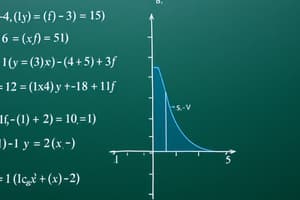Podcast
Questions and Answers
Which of the following statements accurately describes a rational function, as defined in the text provided?
Which of the following statements accurately describes a rational function, as defined in the text provided?
Consider the function f(x) = log₂(x + 3). Which of the following values is NOT in the domain of this function?
Consider the function f(x) = log₂(x + 3). Which of the following values is NOT in the domain of this function?
A function f(x) is called 'onto' if:
A function f(x) is called 'onto' if:
What is the degree of the polynomial function y = 3x⁵ - 2x² + x + 7?
What is the degree of the polynomial function y = 3x⁵ - 2x² + x + 7?
Signup and view all the answers
Which of the following functions is NOT bijective?
Which of the following functions is NOT bijective?
Signup and view all the answers
Which of the following is a characteristic of a linear function?
Which of the following is a characteristic of a linear function?
Signup and view all the answers
Given the function f(x) = 2x - 3, what is the value of f(5)?
Given the function f(x) = 2x - 3, what is the value of f(5)?
Signup and view all the answers
What is the relationship between exponential functions and logarithmic functions?
What is the relationship between exponential functions and logarithmic functions?
Signup and view all the answers
What is the primary purpose of a graph in the context of functions?
What is the primary purpose of a graph in the context of functions?
Signup and view all the answers
Which of the following scenarios would restrict the domain of a function?
Which of the following scenarios would restrict the domain of a function?
Signup and view all the answers
When performing operations on functions, what is not a possible result?
When performing operations on functions, what is not a possible result?
Signup and view all the answers
How can one determine the inverse of a function?
How can one determine the inverse of a function?
Signup and view all the answers
What is the definition of function composition?
What is the definition of function composition?
Signup and view all the answers
Study Notes
Functions: Definitions and Basic Concepts
- A function is a relation between a set of inputs (domain) and a set of possible outputs (range) with the property that each input is related to exactly one output.
- Functions are often represented by equations, where the output (often denoted by 'y' or 'f(x)') depends on the input (often denoted by 'x').
- The domain of a function is the set of all possible input values. This might be all real numbers, or a subset thereof.
- The range of a function is the set of all possible output values.
Types of Functions
- Linear functions: These functions have the general form y = mx + b, where 'm' is the slope and 'b' is the y-intercept. The graph of a linear function is a straight line.
- Quadratic functions: These functions have the general form y = ax² + bx + c, where 'a', 'b', and 'c' are constants. The graph of a quadratic function is a parabola.
- Polynomial functions: These functions involve exponents of the input variable (x), like y = x³ − 2x² + 4x + 1. The highest power of x determines the degree of the polynomial.
- Rational functions: These involve quotients of polynomial functions, like y = (x² + 2x) / (x - 1). Defined for all values of x except those that make the denominator zero.
- Exponential functions: These functions have the general form y = ax, where 'a' is a constant, describes growth or decay. Exponents are the input value.
- Logarithmic functions: These are the inverse of exponential functions, i.e. they solve the problem of finding the exponent. General form: y = loga(x).
Function Notation
- Using 'f(x)' notation, 'f' represents the function name; 'x' represents an input to the function; 'f(x)' represents the output for the corresponding input
Function Properties
- One-to-one functions: Each output corresponds to exactly one input. A horizontal line drawn through the graph will cross it at most one time.
- Onto functions: A function is onto or surjective if every element in the range is mapped to by at least one element in the domain.
- Injective functions: As above, each output corresponds to exactly one input.
- Bijective functions: A bijective function is one that is both one-to-one and onto: each element in the range is related to exactly one element in the domain, and each element in the domain is related to exactly one element in the range. Often they have inverse functions.
Graphing Functions
- Graphs provide a visual representation of the relationship between the input and output.
- The x-axis typically represents the input (domain) and the y-axis represents the output (range).
- Key features like intercepts (where the graph crosses the axes), maxima/minima, and asymptotes can be identified from the graph.
Domain and Range
- Determining the domain and range often involves considering the definition of the function and potential restrictions on the input values to avoid division by zero, non-real number outputs or undefined values.
Function Operations
- Functions can be added, subtracted, multiplied, or divided, creating new functions.
Inverse Functions
- An inverse function reverses the effect of a given function.
- Finding an inverse function might involve switching x and y in the function's equation and then solving for y.
Composition of Functions
- Combining functions such that the output of one function is the input of another function is often called composition of functions.
- The notation for composition of function f and g could be written f(g(x)).
Studying That Suits You
Use AI to generate personalized quizzes and flashcards to suit your learning preferences.
Description
This quiz explores the fundamental concepts of functions, including their definitions, domains, and ranges. You'll also learn about different types of functions such as linear, quadratic, and polynomial functions, alongside their equations and graphical representations.




